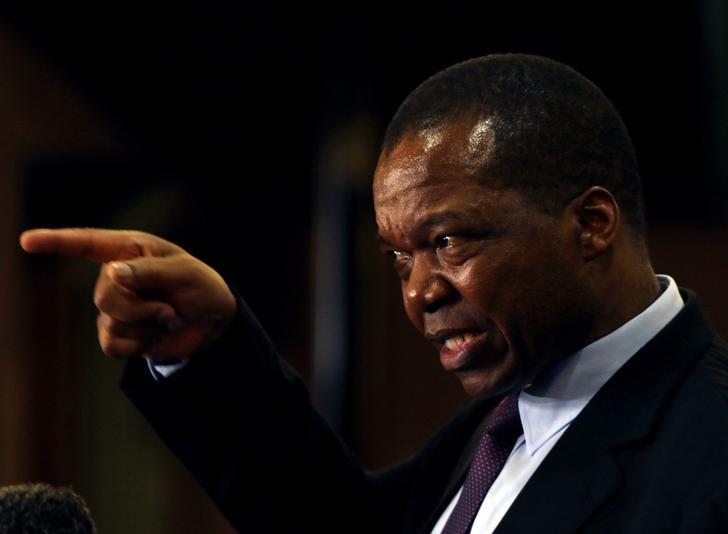Economic case: the market will judge
THE cocktail of policy interventions announced by the Reserve Bank of Zimbabwe (RBZ) on Tuesday, following an ad hoc meeting of the bank’s monetary policy committee (MPC) appear to have done little to convince market watchers that “the firefight” measures carry sufficient potency to quell a meltdown threatening to spin out of control.
Under the new policy measures the RBZ this week started selling foreign currency through its wholesale auction for banks, which would in turn sell to their customers. RBZ governor Dr John Mangudya said the new measures were calculated to ensure that the interbank market foreign currency market became the primary source for foreign exchange needs in the economy.
The interbank market is expected to overtake the central bank’s weekly auctions that have carried the burden for just under three years since the middle of 2020.
In taking measures to address issues affecting the economy, the Governor said the bank’s MPC noted that the prevailing volatility in the exchange rate emanated from both supply-side and demand-side factors.
Mangudya said the supply-side factors reflected the transitory reduction in foreign currency inflows, while the demand factors reflected the sustained value-preservation demand for foreign currency in the economy. Zimbabwe’s domestic currency has, however, continued to weaken on the parallel market, despite the policy interventions announced by the Treasury last week to rein in the exchange rate tailspin, which included the transfer of all external obligations from the central bank to the Treasury.
The domestic unit, which was reintroduced at $2,5/US$1 in February 2019, now trades at $5 5 00/US$1 on the parallel market. It has also lost considerable ground on the official market after authorities recently allowed it to float freely.
The Zimbabwe dollar now trades at $4 868.51/US$1 on the official interbank market. The free fall of the local currency has driven rapid price increases across the economy.
As part of the policy measures by the Treasury last week, Finance and Economic Development Professor Minister Mthuli Ncube said the foreign currency auction system would be refined to a pure Dutch Auction market while available funds weekly would be limited to US$5 million.
The auction, Mangudya said, would operate as a price discovery mechanism, while the interbank market would be made the main source of foreign currency with prices being determined by the market.
The Government committed to continue to sterilise excess liquidity already injected into the economy through the issuance of Treasury Bills while charging the Reserve Bank Zimbabwe (RBZ) to sterilise excess liquidity through appropriate monetary policy tools.
All customs duties, the Treasury chief said, would now be payable in local currency except designated ‘luxury goods’, which is expected to encourage wider use of the domestic currency and strengthen the exchange rate.
Analysts are, however, little convinced that enough has been done yet to stop an economic meltdown from exchange rate volatility and warned only time will tell while stressing the market would have the final say.
Economist Eddie Cross cast aspersions on the effectiveness of the new measures saying he did not see how they would put the situation under control.
“I do not honestly know if this will work. I do not know what their intentions are. They are desperately trying to get the devaluation of the local currency under control and they are not succeeding.
”So, this is pushing the authorities to adopt more and more radical measures but I really do not know what they mean by that (foreign currency wholesale)”.
He said the real objective of the central bank was to liberalise the interbank market. Cross, however, said the market would be the ultimate judge and “we have to wait and see what the reaction of the market is to changes. “If the market responds by fixing a rate then it is at the moment they are winning, if it doesn’t, they are not winning,” he said.
“The judgment on last week’s measures was totally negative; the rate has started running again.
Economist and MPC member Persistence Gwanyanya said the objective behind the introduction of the wholesale forex auction was to liquefy the wholesale market, get it going and allow exporters and buyers on the interbank market to determine prices and have confidence in its operations.”
“We are more concerned about liquefying the wholesale market. It lays the ground so that the market, going forward, is able to self-liquidate. We want the sellers to freely participate, as long as this is an economic and viable rate, what should stop them from selling” he said.”
We are starting the (foreign exchange market), but we also want to sustain it beyond just kick-starting it.”
Gwanyanya said all market players would soon start participating as long as they see the exchange rate stabilising. He said the central bank will not force exporters to liquidate their balances beyond the mandatory surrender portion of 25 percent of earnings because exporters “must freely like the rate”.
Equities research firm Equity Axis, weighed in saying the new arrangement completed the shift to a market-driven exchange rate system under the Willing Buyer Willing Seller Interbank system, a decentralised system run by banks.
However, the firm said the effectiveness of the RBZ’s weekly auction was limited by caps on tradeable amounts per bid and its movement capped against a present rate from the latest auction.
These limits were US$100 000 maximum bid and a 10 percent movement cap against the auction.
These limits prohibited the effectiveness of the respective market as a market maker as bigger players were not able to participate (demand) given the bid size allowable.
Further, Equity Axis said the caps against the auction deterred sellers given its variance to real market rates, presumably reflected through parallel markets.
Equity said expressed reservations on RBZ’s decision to maintain the auction system so it continues to operate for meeting smaller requirements for foreign payments and for continuous price discovery.
“It is not clear how the failed auction system can achieve the objective of continuous price discovery even so with suppressed supply levels and a more diminished overall contribution to total trades.
“If the auction market shifts in earnest from the managed Reuters system to Dutch, a shift in the bidding process, now prioritising higher bids, may result in a more market reflective rate, but with flows limited to only US$50 000, this market should not be allowed to set the rate as before, despite changed trading conditions regarding the bidding criteria.
“To improve market confidence and do away with speculation and suspicion, the auction market has to be completely scrapped.
“The only reason why the RBZ will choose to retain it, is to position itself for intervention if the interbank gives “unfavourable” outcomes.
“The bank is used to managing the rate and therefore anticipation of spikes unsettles it and would want to quickly intervene in the event of unfavourable outcomes emerging. Batanai Matsika, a Harare-based investment analyst said the policies are not timely, because they are coming at a time when confidence is low in the Zimbabwe dollar.
“What tends to happen is that the deterioration of the currency is not just about the money supply dynamics, but because of the uncertainty that is coming through as a result of upcoming elections.
“So this creates a lot of excessive demand for US dollars even if you move towards the floating exchange rate, that will always be economic agents using the USD as a safe haven asset,” he said.
Matsika added that measures should have been introduced a long time ago when there still was a modicum of confidence in the domestic currency, as it is these could lead to more uncertainty and widening of the exchange rate gap.-ebusinessweekly










